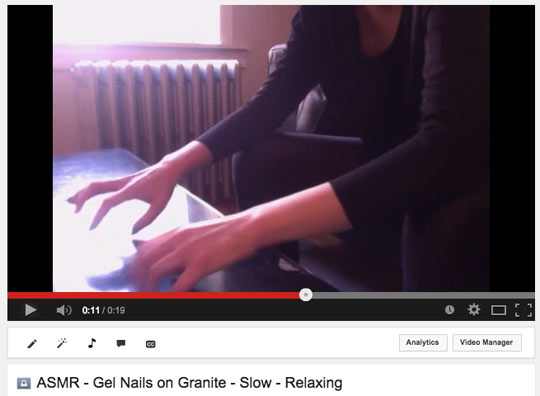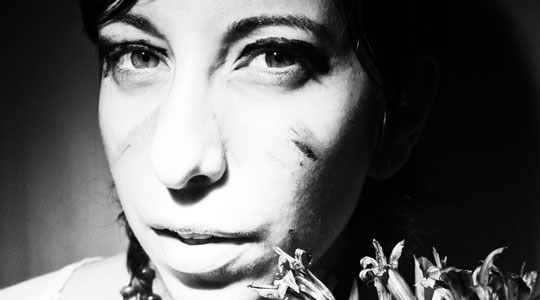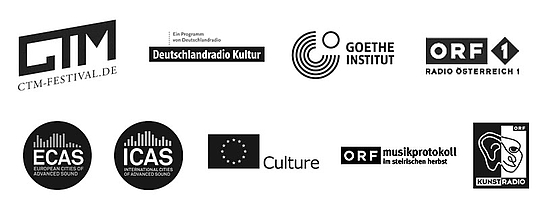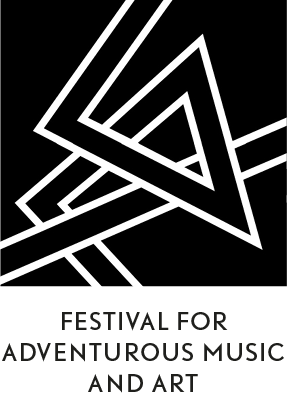CTM 2015 Radio Lab
Commissioned Works

Returning for a second edition, the CTM 2015 Radio Lab is dedicated to exploration and experimentation within the medium of radio. The Lab programme will two projects commissioned by Deutschlandradio Kultur - Hörspiel/Klangkunst and CTM Festival, in collaboration with the Goethe-Institut, ORF musikprotokoll im steirischen herbst, Ö1 Kunstradio, and ICAS/ECAS – International Cities for Advanced Sound.
The CTM 2015 Radio Lab Open Call for works sought unusual ideas for pairing the specific artistic possibilities of radio with the potentials of live performance or installation, that also explore the CTM 2015 Festival theme: Un Tune – Exploring Sonic Affect. The two selected works will premiere at CTM 2015, and subsequently be broadcast via Deutschlandradio Kultur as well as presented by the ORF (Austrian National Broadcasting Corporation).
Claire Tolan :: Always Here for you: ASMR

The first of two Radio Lab projects, entitled Always Here for you: ASMR - Autonomous Sensory Meridian Response, comes from Berlin-based American Claire Tolan, a young artist and programmer exploring human-computer interaction, online communities (intimacy, privacy), and information structures and theory.
→ Read the open call seeking ASMR performers for Claire Tolan's installation here.
ASMR is defined as a pleasurable “tingling” sensation in the scalp, spine, and peripheral regions of the body in response to cognitive stimuli such as visual, auditory, tactile or olfactory sensations. The phenomenon remains a pseudoscience with little or no scientific explanation of verified data to support it. It has, however, grown strong anecdotal evidence thanks to a considerable cult following and the development of a devoted community of followers who find a home – and post millions of “healing” videos – on YouTube. Recorded binaurally and varying from role-plays of hotel attendants and spa treatments, to affirmation videos and videos recording soft sounds such as whispering, nail tapping, or brushing, these clips mimic everyday situations of closeness and allow for relaxation and sharing of personal experiences. But what happens to the sounds and intimacy of these video encounters when the visual element is removed? Is the soothing tingling experience purely sonic, or some way dependent upon the visual cues in the videos?
On a first level, Tolan proposes an exploration of the interplay between sight and sound, inviting the audience to compare their ASMR viewing experience with real versus recreated sounds. Audio waves cause objects to vibrate at a frequency that is not perceived by the human eye. By recording ASMR videos with a simple point-and-shoot camera to capture these movements, then using algorithms developed by MIT to process them back into sound, Tolan aims to test the effect of short-circuiting the visual and aural. In a further experiment, sound from ASMR role-plays will be detected by a laser microphone and recreated, testing whether ASMR can be provoked despite a slightly incongruent soundtrack. Through her use of the laser microphone and audio extraction algorithms, Tolan opens the door to a second level of investigation into surveillance technology – for which radio has long been a primary medium both as enabler and circumventer.
By connecting ASMR to the latest developments in acoustic surveillance technologies and computation, Claire Tolan renders visible the workings, potentials and dangers of being able to control and analyze the frequency domain, which serve as a basis of all forms of human communication and perception. She draws possible future scenarios that are most timely to address. On another level, her proposal investigates the complex intertwinement of direct physiological effects of frequencies and the psychological effects of narratives, role-playing, and intimacy, and on the possibilities of new forms of intimacy mediated by communication technologies. This makes her proposal of high interest not only for live presentation but also for radio, as it allows her to probe and advance radio’s potential for such forms of closeness.
Sol Rezza :: In the Darkness of the World

The second Radio Lab project, In the Darkness of the World, takes shape as an experimental radio play that pulls the hydrophone away from its primarily scientific usage into the realm of storytelling, to recount a tale through sound – namely Jules Verne’s 20,000 Leagues Under the Sea.
Proposed by Sol Rezza, an Argentinean radio producer and sound designer based in Mexico City, the project explores the dark, underwater world where light is scarce and the only consistent guide is sound. Using 3D acousmatic sound, the play experiments with spatial capabilities of live and radio contexts while inviting listeners to experience a sonic environment not normally lived by humans - where life takes place under different circumstances that often still remain unknown. The Wire’s Frances Morgan on Rezza’s project: “The project is imaginative and playful, drawing on classic radiophonic drama, and its spatial aspect should make the installation inviting and accessible.”
Partners
CTM – Festival for Adventurous Music and Art
CTM is the leading festival for innovative pop, electronic, and experimental music in Germany. With a mix of concerts and club events, the festival has implemented programming at numerous bastions of Berlin nightlife and culture, and presents internationally renowned artists alongside exhibitions, talks, film screenings, and workshops. International, intensely networked, and always in close contact with artists, professionals, and the public, CTM’s year-round activities make critical contributions to a vibrant and artistically innovative music culture. Extending beyond the conventional parameters of a music festival, CTM is a platform for thinking about music, its social relevance, and the conditions from which it emerges. As a partner to Berlin’s concurrent international festival for art and digital culture broadcasting, transmediale, CTM is resonant and relevant entity across all creative tropes.
Deutschlandradio Kultur – Hörspiel/ Klangkunst
The weekly “Klangkunst” ("Sound Art") broadcast (formerly “Hörspiel Werkstatt” (“Radio Play Workshop”) was launched in January 1995 by Deutschlandradio Kultur, German National Radio’s cultural programme. The broadcast was established to extend the formal possibilities of radio play, to experiment with new genres, and to introduce listeners to outstanding examples of international sound art. The programme covers the entire range of new radio art, from experimental sound play to poetry, text-sound collages, soundscapes, multilingual compositions, and electronic and digital radio performances. International networking and exchange among international radio artists are critical dimensions of the programme. Klangkunst is understood as a laboratory for testing the widest possible range of sounds. The programme draws from the varied motifs of diverse sonic environments, creating new amalgams of sound dramaturgy, narrative structures, compositional arcs, and characteristics of radio as a medium. Klangkunst is a member of the Ars Acoustica group of the European Broadcasting Union (EBU).
→ dradio.de/dkultur/sendungen/klangkunst/382602/
Goethe-Institut
The Goethe-Institut is the Federal Republic of Germany’s worldwide cultural institute. It promotes knowledge of the German language abroad and fosters international cultural cooperation. The Goethe-Institut provides a comprehensive picture of Germany by disseminating information on the country’s cultural, social, and political life. Through a network of Goethe-Institut offices, centres, cultural societies, and reading rooms / language examination and learning centers, the Goethe-Institut has promoted worldwide cultural and educational policy for over sixty years.
ECAS – European Cities of Advanced Sound / ICAS – International Cities of Advanced Sound
Networking Tomorrow's Art for an Unknown Future is a project supported by the European Commission Culture Programme and an initiative of ECAS – European Cities of Advanced Sound, a consortium of European members of the international network ICAS – International Cities of Advanced Sound. Thirty-five organizations and festivals on four continents have joined forces to support mutual development and to promote artistic practises at the interface of music, art, technology and society. Important goals include the exchange of knowledge, capacity building, best practices, and shared cultural and political work.
The ECAS project, Networking Tomorrow's Art for an Unknown Future (2010–2015), is a collaborative European platform for new forms of experimental artistic work within the fields of sound, music, and current technologies. In addition to promoting critical artistic practice, the project aims to re-think the structures that underlie and support these practices through ECAS conferences and meetings, co-productions, artist residencies, and artist and researcher production grants.
→ icasnetwork.org
→ ecasnetwork.org
ORF musikprotokoll im steirischen herbst
Austria’s Festival Platform for Contemporary and Experimental Music. Functioning as a kind of laboratory, musikprotokoll invites the audience to embark on an exploratory journey to discover the latest developments and trends in music, with all the artistic risks that this entails. From orchestral music with the ORF Radio Symphonieorchester Wien to chamber music, from live performances to sound installations, musikprotokoll highlights a wide range of intriguingly heterogeneous forms and genres and presents works that are for the most part developed and produced specifically for the festival.
Founded by Emil Breisach in 1968, musikprotokoll is organised annually by ORF (Austrian Broadcasting). It is a co-production of the ORF’s two stations, Radio Österreich 1 (Ö1) and Radio Steiermark, which broadcast presented works in cooperation with the steirischer herbst festival.
Ö1 Kunstradio
Ö1 Kunstradio has dedicated itself to experimental radio art since 1987, with online editions available as of 1995. The show has featured many artistic projects which crosslink radio with tangible, intangible, and public spaces, giving artists an entry point and platform for public radio production and broadcasting.
Partners & Funders

Presenting Partner


